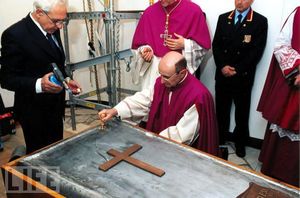 1600 years is a long time. But the Church never forgets. She especially never forgets a sainted monk who called together others to live the Gospel and to pray. Maronite Church who traces her foundation to a monk is remembering his good work and his death of so long ago. Several celebrations around the US mark the anniversary.
1600 years is a long time. But the Church never forgets. She especially never forgets a sainted monk who called together others to live the Gospel and to pray. Maronite Church who traces her foundation to a monk is remembering his good work and his death of so long ago. Several celebrations around the US mark the anniversary.
The Catholic’s perpetual second chance
I try to communicate to others, particularly the friends I teach about the Catholic faith, that to be authentically Catholic one has to fall in love with Jesus, and to do what He does. Mercy and love are constitutive parts of being called a Christian. This not always easy. It is a human struggle for many. But we are called by the Lord Himself to love and pray for your enemies; have mercy on the sinner; forgive injuries; feed the hungry. Not willing to do this, then it would be pretty hard to convince others that your proposed faith in Christ as Lord and Savior is true. The Pope’s Angelus address earlier today gives us a clue to my point: to be a Catholic means living in the mindset of having a perpetual second chance. Read the 2 papal paragraphs:
On this seventh
Sunday of Ordinary Time the biblical readings speak to us about God’s will to
make men participants in his life: “Be holy because I the Lord your God am
holy,” we read in the Book of Leviticus (19:1). With these words and the precepts
that follow from them, the Lord invited the Chosen People to be faithful to the
covenant with him, walking in his ways, and established the social legislation
on the commandment that says that “you will love your neighbor as yourself”
(Leviticus 19:18). If we listen, then, to Jesus in whom God took on a mortal
body to become every man’s neighbor and reveal his infinite love for us, we
hear again that same call, that same objective audacity. The Lord, in fact,
says: “Be perfect as your Father in heaven is perfect” (Matthew 5:48). But who
can become perfect? Our perfection is to live as children of God in humility
concretely doing his will. St. Cyprian wrote that “to God’s paternity there
must correspond a conduct as children of God so that God might be glorified and
praised by man’s good conduct” (De zelo et livore, 15: CCL 3a, 83).
In what way
can we imitate Jesus? Jesus himself says: “Love your enemies and pray for those
who persecute you so that you will be children of your Father who is in heaven”
(Matthew 5:44-45). He who welcomes the Lord in his life and loves him with all
of his heart can begin again. He is able to do God’s will: to realize a new
form of existence animated by love and destined for eternity. Paul the Apostle
adds: “Do you not know that you are God’s temple and that God’s Spirit lives in
you?” (1 Corinthians 3:16). If we are truly aware of this reality and our life
is deeply formed by it, then our witness becomes clear, eloquent and
efficacious. An [early Christian] author wrote: “When the whole being of man is
mixed, so to speak, with God’s love, then his soul’s splendor is also reflected
on the outside” (John Climacus, Scala Paradisi, XXX: PG 88, 1157 B), in the
whole of his life. “Love is a great thing,” we read in “The Imitation of
Christ,” [it is] “a good that makes every heavy thing light and easily endures
every hardship. Love aspires to sail on high, not to be held back by any
earthly thing. It is born of God and only in God can it find rest” (III, V, 3).
Did God Correct Himself?
Today’s Gospel from Saint Matthew poses a crucial question for our following Christ: How do we do it? The line that is frequently often misunderstand:
was said, An eye for an eye and a tooth for a tooth. But I say to you, offer no
resistance to one who is evil.
try to keep the mind in quietness. For if the eye is constantly shifting its
gaze, one moment this way or that, then veering between upwards and down, it
cannot see clearly what lies directly in front of it. It has to bring its
gaze to bear on this object so as to see it clearly in focus. In the same way a
mind distracted by thousands of worldly concerns cannot possibly bring a steady
gaze to bear on the truth.
What is Septuagesima Sunday?
If you don’t pray the 1962 Missal at today’s Mass you would have missed the liturgical observance of Septuagesima Sunday. Those who prayed the Missal of Pope Paul VI heard the gospel of “an for an eye.” But what is Septuagesima Sunday and what would it mean to us today as Lent approaches? How does it relate to the overall liturgical life of the Church? There are several parts of the sacred Liturgy that face a startling change. There is a certain beauty and richness in the older liturgical tradition that seems to have been lost in the post Vatican II revisions…but that’s a theme for another time.
The famous Benedictine monk and writer of the 19th century, Dom Prosper Gueranger, gives perspective on the Season of Septuagesima:
separates us from the great feast of Easter.
the season of Septuagesima into her calendar. Let us now meditate on the doctrine hidden under the symbols of her liturgy. And first, let us listen to St. Augustine, who thus gives is the clue to the whole of our season’s mysteries.
‘There are two times,’ says the holy Doctor: ‘one which is now, and is spent in the temptations and tribulations of this life; the other which shall by then, and shall be spent in eternal security and joy. In figure of these, we celebrate two periods: the time before Easter, and the time after Easter. That which is before Easter signifies the sorrow of this present life; that which is after Easter, the blessedness of our future state… Hence it is that we spend the first in fasting and prayer; and in the second we give up our fasting, and give ourselves to praise.’
us, and having been buried together with Him, we shall rise again with Him to a new life.
Blessed Christopher of Milan
God of all truth, you made Blessed Christopher a
faithful herald of your word to the people. By his life and ministry may we
keep Christ ever in our thoughts and in the love of our hearts.
Discovering the Way: El Camino de Santiago
 Salt + Light TV has given a wonderful gift in doing a terrific story on the ancient pilgrimage trail called in Spanish, El Camino de Santiago. The Way of Saint James. Alessia Domanico is the host of “Discovering the Way: El Camino de Santiago.”
Salt + Light TV has given a wonderful gift in doing a terrific story on the ancient pilgrimage trail called in Spanish, El Camino de Santiago. The Way of Saint James. Alessia Domanico is the host of “Discovering the Way: El Camino de Santiago.”
- a great adventure, go for a purpose: you’ll grow spiritually and physically
- an opportunity to pray, to do penance, to be reminded of tradition
- catechesis on the faith
- an opportunity to learn Christian and civil history
- to know your own humanity, that of the other
- learn and experience the christian faith
- have the goal to go to the Cathedral of Saint James to visit the relics of a great Apostle.
Transitioning from Husar to new era in the Ukrainian Church …?
 In the past weeks we’ve seen the Pontiff accepting the resignation of His Beatitude Cardinal Lubomyr Husar, 78, as the Major Archbishop of the Ukrainian Catholic Church. Bishop Ihor Voznyak is the temporary administrator of the Church until a new leader is elected.
In the past weeks we’ve seen the Pontiff accepting the resignation of His Beatitude Cardinal Lubomyr Husar, 78, as the Major Archbishop of the Ukrainian Catholic Church. Bishop Ihor Voznyak is the temporary administrator of the Church until a new leader is elected.
Continue reading Transitioning from Husar to new era in the Ukrainian Church …?
John Paul II’s coffin to be viewed
 The Holy See is allowing the coffin of Pope John Paul II to be viewed following the May 1st beatification ceremony which will be celebrated by Pope Benedict XVI.
The Holy See is allowing the coffin of Pope John Paul II to be viewed following the May 1st beatification ceremony which will be celebrated by Pope Benedict XVI.
Church’s use of the Net too often answers questions not asked
Kyle Logue’s essay on Christian Web Trends, “4 Reasons Why Church Websites Don’t Attract Visitors“. Kyle pinpoints a number of good things to keep in mind for the work sharing the faith with the outside world. Pay attention! His list includes:
- lack of interaction
- no easy way to share content
- lack of good content
- lack of purpose.
Beatification ceremonies for John Paul II are FREE
The Prefecture of the Papal Household, having been
informed of the existence of unauthorised offers by some Tour Operators,
especially on internet, of assistance in procuring tickets, with a service
charge, for General Audiences and Papal ceremonies, particularly for the
Beatification of the Servant of God John Paul II on Sunday, May 1, wishes to
make it clear that:
clear from the outset, no tickets are required.
Prefecture of the Papal Household for General Audiences and Papal ceremonies
are always issued FREE of charge and no person or organization can request any
kind of payment.
